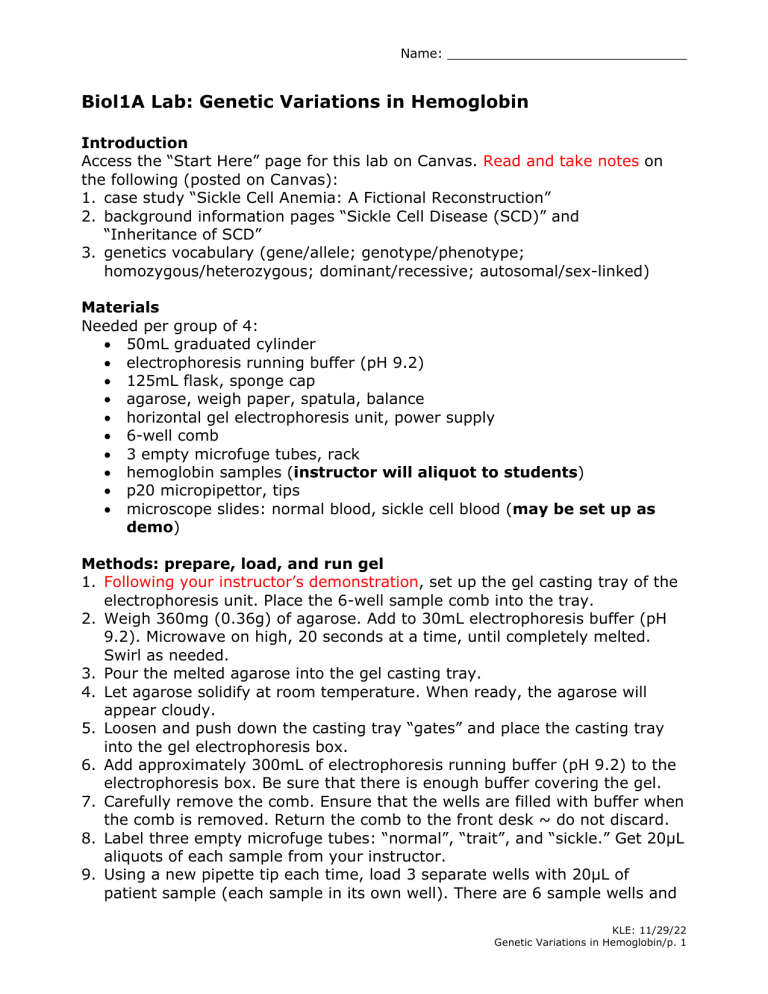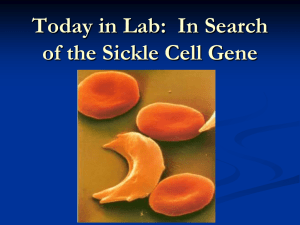
Name: ______________________________ Biol1A Lab: Genetic Variations in Hemoglobin Introduction Access the “Start Here” page for this lab on Canvas. Read and take notes on the following (posted on Canvas): 1. case study “Sickle Cell Anemia: A Fictional Reconstruction” 2. background information pages “Sickle Cell Disease (SCD)” and “Inheritance of SCD” 3. genetics vocabulary (gene/allele; genotype/phenotype; homozygous/heterozygous; dominant/recessive; autosomal/sex-linked) Materials Needed per group of 4: • 50mL graduated cylinder • electrophoresis running buffer (pH 9.2) • 125mL flask, sponge cap • agarose, weigh paper, spatula, balance • horizontal gel electrophoresis unit, power supply • 6-well comb • 3 empty microfuge tubes, rack • hemoglobin samples (instructor will aliquot to students) • p20 micropipettor, tips • microscope slides: normal blood, sickle cell blood (may be set up as demo) Methods: prepare, load, and run gel 1. Following your instructor’s demonstration, set up the gel casting tray of the electrophoresis unit. Place the 6-well sample comb into the tray. 2. Weigh 360mg (0.36g) of agarose. Add to 30mL electrophoresis buffer (pH 9.2). Microwave on high, 20 seconds at a time, until completely melted. Swirl as needed. 3. Pour the melted agarose into the gel casting tray. 4. Let agarose solidify at room temperature. When ready, the agarose will appear cloudy. 5. Loosen and push down the casting tray “gates” and place the casting tray into the gel electrophoresis box. 6. Add approximately 300mL of electrophoresis running buffer (pH 9.2) to the electrophoresis box. Be sure that there is enough buffer covering the gel. 7. Carefully remove the comb. Ensure that the wells are filled with buffer when the comb is removed. Return the comb to the front desk ~ do not discard. 8. Label three empty microfuge tubes: “normal”, “trait”, and “sickle.” Get 20µL aliquots of each sample from your instructor. 9. Using a new pipette tip each time, load 3 separate wells with 20µL of patient sample (each sample in its own well). There are 6 sample wells and KLE: 11/29/22 Genetic Variations in Hemoglobin/p. 1 Name: ______________________________ only 3 samples, so it is best to use the center wells of the gel. Record which sample went into each well. 10. Once the samples are loaded, place the lid onto the electrophoresis box and attach the leads to the power supply (red to red, black to black). Be sure that the power supply is turned off before doing this step! 11. When all cables are connected, turn the power supply on and set to 100150 volts (current should read 50-100 milliamps). 12. Keep an eye on the blue dye. This will “tell” you when to shut of the power supply. The dye runs faster than the hemoglobin proteins. Turn off the power supply when the dye front has reached the bottom centimeter of the gel. This may take approximately 1 hour. 13. Use this time to observe the prepared microscope slides (normal vs. sickle cell blood) and answer the post-lab questions, as possible. 14. When finished with the electrophoresis step, turn off the power supply. 15. Remove the cables and carefully lift the casting tray with gel out of the electrophoresis box. 16. Slide gel onto a light box and observe the bands of hemoglobin. Sketch the bands in the results section. Clean up – did you: _____ put used pipet tips, weigh paper/weigh boats, microfuge tubes into trash? _____ put your gel into the trash (it’s ok, not hazardous)? _____ rinse dirty glassware and place in appropriate glassware containers? _____ leave buffer in electrophoresis chambers for the next lab sections to use; if you are the last lab section, pour buffer back into “used buffer” container? _____ rinse gel casting tray and leave to air dry? _____ wipe down lab bench with bench wash solution? KLE: 11/29/22 Genetic Variations in Hemoglobin/p. 2 Name: ______________________________ Genetic Variations in Hemoglobin Results and post-lab Questions 1. While your gel is running, answer questions a-e using the information and data presented in the case study. a. How many different hemoglobin proteins do you see on the gel? b. What could cause different rates of migration of the hemoglobin proteins toward the positive end of the gel? c. Since all hemoglobin proteins are roughly the same size, what is the difference between the hemoglobin proteins you see on the gel? d. If samples 48WC03 and 48WC15 came from patients diagnosed with SCD, how (specifically) do their hemoglobin proteins differ from the others? e. What is a possible explanation for sample 48WC12? 2. Sketch your gel electrophoresis results. Label the sample wells with “Normal”, “Trait” or “Anemia”. Label each band with HbA or HbS. KLE: 11/29/22 Genetic Variations in Hemoglobin/p. 3 Name: ______________________________ 3. According to your results, describe the difference in electric charge between the sickle cell hemoglobin (HbS) protein and the normal hemoglobin (HbA) protein. Hint: look at your answer to question 1d. 4. Sickle cell hemoglobin is different from normal hemoglobin only by a single amino acid change. Review the structures of amino acids (use figure 5.14 in your text) and give the name of four amino acids which could have replaced the normal amino acid to give the electrophoretic behavior you saw with sickle cell hemoglobin. 5. Draw the structure of valine, with its appropriate charges, at pH 2.0 and pH 9.2. Use figure 5.14 in your text to help you ~ but don’t just copy the figure, the charges shown in the figure are the prevailing charges at pH 7.2 (cytoplasmic pH). pH 2.0 pH 9.2 6. Draw the structure of glutamic acid, with its appropriate charges, at pH 2.0 and pH 9.2. Use figure 5.14 in your text to help you ~ but don’t just copy the figure, the charges shown in the figure are the prevailing charges at pH 7.2 (cytoplasmic pH). pH 2.0 pH 9.2 KLE: 11/29/22 Genetic Variations in Hemoglobin/p. 4 Name: ______________________________ 7. There are other abnormal hemoglobin protein molecules found in the human population. Can all abnormal hemoglobin molecules be diagnosed by electrophoresis? Explain your answer. 8. Calculate the net charge on this protein in a solution at pH 2.0. Don’t forget to add in the terminal amino and carboxyl groups at the ends of the protein! Use figure 5.14 in your text to help you. Lys-Ala-Gly-Asp-Asn-Leu-Cys-His-Thr-Glu-Met-Gln-Arg-Tyr-Ile Net charge = _____ 9. Calculate the net charge on this protein in a solution at pH 10. Don’t forget to add in the terminal amino and carboxyl groups at the ends of the protein! Use figure 5.14 in your text to help you. Met—Arg—Gly—Glu—Trp—Phe—Glu—Lys—His—Cys—Met—Ala—Ala Net charge = _____ KLE: 11/29/22 Genetic Variations in Hemoglobin/p. 5 Name: ______________________________ 10. Sketches of normal and sickle cell anemia human blood smears– draw the field of view for each. Normal Human Blood Smear Total Magnification = _____ Sickle Cell Anemia Human Blood Smear Total Magnification = _____ 11. What are the chances that offspring of a normal parent and a parent with sickle cell trait will have sickle cell trait? Use a Punnett Square to answer this question. 12. Fill out this table: Hb b gene genotype Allelic relationship HbAHbA HbAHbS HbSHbS _____ zygous _____ zygous _____ zygous Molecular phenotype (Hb protein) Cellular phenotype (RBC shape) Organismal phenotype (disease state) KLE: 11/29/22 Genetic Variations in Hemoglobin/p. 6 Name: ______________________________ Figure 5.14 from your text: KLE: 11/29/22 Genetic Variations in Hemoglobin/p. 7


